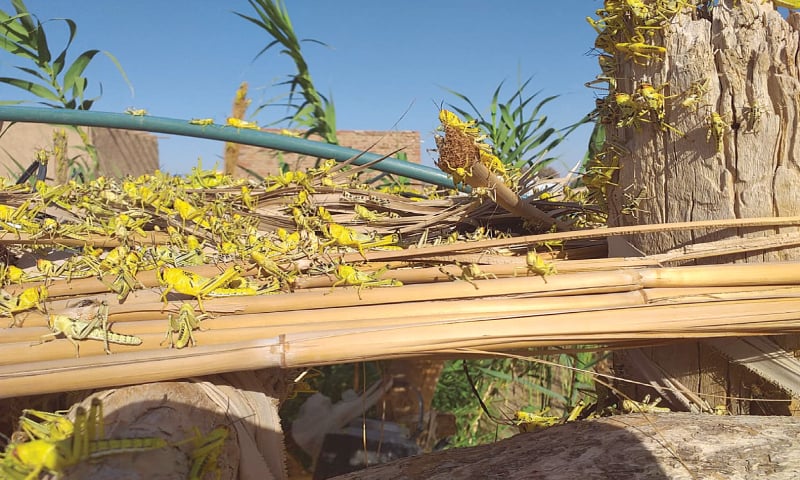ON the first day of Eid in Dalbandin, the headquarters of district Chagai, residents of the dusty town are alarmed: an army of locusts has arrived in its surrounding areas and in the southern part of the town. Since then, the sandy areas of southern parts of Dalbandin are kind of moving with lumps of locusts. And the locals are afraid to go there. Their fears doubled up following the pouring of locusts into the populated areas of Dalbandin city in Killi Khan Jan, Killi Kohi Khan and Killi Khuda Raheem.
One of the residents is Abdur Rehman Baloch, a well-known artist. The locusts have been pestering him for over the last two days. Neatly combed and dressed in his traditional Balochi shalwar-kameez, Rehman asks us to follow his motorbike, in the tortuous streets of Killi Khan Jan, to reach his house. The streets are replete with locusts. Stopping in every corner of his street, he points towards them, climbing up the walls and entering houses.
We stand in the middle of a Killi Khan Jan street. Locusts freak out Dalbandin-based journalist Ali Raza Rind, accompanying me, by falling on him one by one from the walls. Rehman says, laughing, “That’s what happened to me the first time I encountered them. But now I am used to them. With locusts in my room, I now sleep without being disturbed.”
Situated in the heart of the city, Killi Khan Jan has hundreds of houses. Former minister Sardar Atif Sanjrani hails from here, elected in 1997 for a National Assembly seat. There are several katcha houses made up of mud. One of them belongs to Rehman. “The locusts have left no greenery and the few plants I had planted,” says Rehman, showing us dead locusts under his partially damaged date palm tree. “If these locusts continue to wreak havoc in our town, no plant or tree would be left. They are now trying to reach the main bazaar of Dalbandin.”
In front of his house, there is an open, plain area. Other than two big trees, there is sand all around. Ahmad Mohammad Hassani is sitting under the shade of one of the trees. A friend told him in the morning that in ancient past there used to be a village in Kharan. When an army of locusts entered the village, the locusts destroyed it in toto. Still, locusts are eating up a pomegranate tree in his small courtyard. “It used to be thick,” he recalls. “But it is now reduced to the ground.”
Zaheem Baloch used to have a wonderful but small garden filled with pomegranate and date palm trees. Here, in the evenings, he would have tea with his children. But since the arrival of locusts, the insects have been eating up his garden and the trees. Today, he was angry to the extent that he chopped down the trees eaten up by the locusts. “They had destroyed the trees, and the trees looked ugly,” a frustrated Zaheem tells Dawn. “I chopped them down.”
Locals assert this is the first time that locusts have arrived in such large numbers. But elderly and turbaned Hafiz Nasrullah disagrees. According to him, this is the second time. “In 1990, locusts arrived in Dalbandin, in lumps after lumps,” he tells Dawn in Faisal Colony, agreeing, “this time, though, their number is more than what one can imagine”.
Locals claim that the locusts have come from Panjgur, Washuk and Kharan districts. At the same time, they are also reproducing and increasing in number, they add. In the words of farmer Yaqoob, “the locusts leave nothing in cultivated lands, including the stems of thick trees. They can eat up a tree in an hour, like termites.”
Understandably, the local administration of district Chagai is not capable of exterminating the swarm of locusts. After two days, with the help of local administration, Aftab Baloch, the local head of Food and Agriculture Organisation in Dalbandin, and Zahoor Ahmad Shah of the Agriculture Department surveyed the areas on Saturday. And on Sunday, they began spraying.
“Although we have sprayed, they are still present in large numbers in Siah jungle, a semi-agricultural area. They are moving towards agricultural areas of Chagai, Padag and Ameenabad. They can destroy the crops over there if remain unchecked,” says Aftab. “Without help from the top and spraying by helicopters, they are unlikely to be exterminated.”
Published in Dawn, June 10th, 2019














































